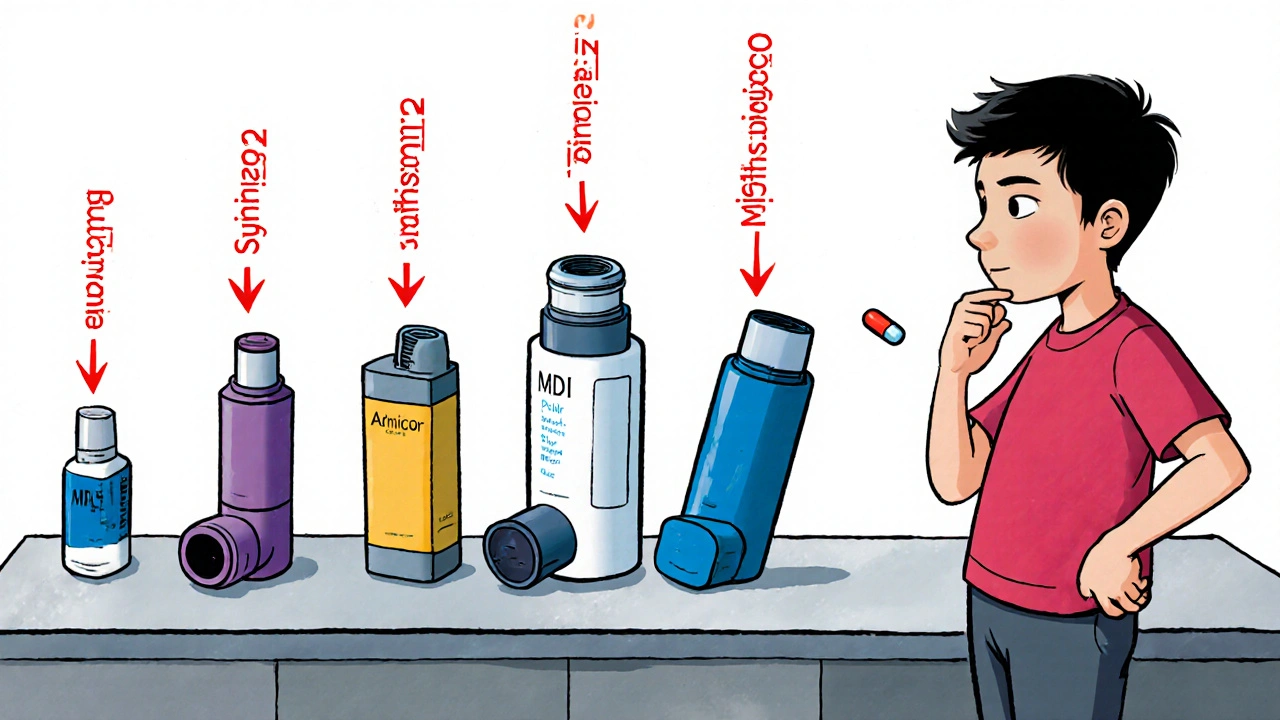Asthma Inhaler Selection Tool
Choose Your Priority Factors
Based on your asthma management needs, select the most important factors:
When treating asthma, Flovent is a brand name for the inhaled corticosteroid fluticasone propionate that helps keep airways from swelling. But with dozens of options on the market, figuring out whether Flovent is the right fit can feel like a maze. This guide walks you through how Flovent works, what you should compare, and how it stacks up against the most common alternatives - all in plain language you can act on today.
What is Flovent (Fluticasone) and how does it work?
Flovent delivers fluticasone propionate straight to your lungs via a metered‑dose inhaler (MDI). The drug belongs to the inhaled corticosteroid (ICS) class, which reduces inflammation by dampening the immune response in airway tissue. You use it daily as a “controller” medication - not for quick relief during an attack.
Key points about Flovent:
- Available in 44 µg, 110 µg, and 220 µg strengths.
- Comes with a built‑in dose counter.
- Designed for patients 4 years and older.
Because it’s an MDI, technique matters. Many patients miss out on benefits simply by not inhaling correctly - a quick video tutorial can save you a lot of wasted medication.
Factors to consider when comparing inhaled steroids
Before jumping into the list of alternatives, keep these criteria in mind. They’ll help you decide what matters most for your lifestyle and health.
- Potency and dose flexibility: Does the drug offer low‑dose options for milder asthma? Can you step up or down easily?
- Device type: Press‑air MDI, dry‑powder inhaler (DPI), or soft mist? Each has a learning curve.
- Frequency of use: Once‑daily vs twice‑daily dosing can affect adherence.
- Side‑effect profile: Look for oral thrush risk, impact on growth in children, or systemic absorption.
- Cost and insurance coverage: Brand‑name inhalers can be pricey; generic equivalents often cost less.
Top alternatives to Flovent
Here’s a quick snapshot of the most frequently prescribed inhaled steroids and combo inhalers that clinicians mention as alternatives.
- Advair - a combination of fluticasone (ICS) and salmeterol (long‑acting beta‑agonist, LABA). Used for both control and mild bronchodilation.
- Symbicort - pairs budesonide (ICS) with formoterol (LABA). Popular for flexible dosing.
- Pulmicort - pure budesonide delivered via a DPI. Good for patients who struggle with MDIs.
- Qvar - beclomethasone dipropionate in a breath‑activated MDI, reducing coordination issues.
- Alvesco - contains ciclesonide, a pro‑drug that activates in the lungs, offering a lower systemic load.
- Montelukast - a leukotriene receptor antagonist taken as an oral tablet. Not an inhaled steroid but often used when patients can’t tolerate inhalers.
Each of these has its own set of strengths and trade‑offs. The table below breaks them down side by side.
| Brand | Generic name | Device type | Typical dose range | Pros | Cons |
|---|---|---|---|---|---|
| Flovent | Fluticasone propionate | MDI (press‑air) | 44 µg - 220 µg, 1-2 puffs BID | Well‑studied, dose counter, widely covered by insurance | Requires good coordination; possible oral thrush |
| Advair | Fluticasone / Salmeterol | MDI (combo) | 100 µg/50 µg - 500 µg/100 µg, 1 puff BID | Combines control + bronchodilation; steady symptom relief | More expensive; higher risk of LABA‑related side effects |
| Symbicort | Budesonide / Formoterol | MDI (combo) | 80 µg/4.5 µg - 320 µg/9 µg, 1-2 puffs BID | Fast‑acting LABA; flexible dosing | May cause jitteriness; cost can be high |
| Pulmicort | Budesonide | DPI | 90 µg - 180 µg, 1-2 inhalations BID | No propellant; easier for kids with poor coordination | Requires dry inhalation technique; pricey without generic |
| Qvar | Beclomethasone dipropionate | MDI (breath‑activated) | 40 µg - 200 µg, 1-2 puffs BID | Breath‑actuated reduces coordination errors | Limited dose options; generic versions less common |
| Alvesco | Ciclesonide | MDI (press‑air) | 80 µg - 320 µg, 1-2 puffs BID | Pro‑drug minimizes systemic exposure; once‑daily option | Higher price; inhaler design less familiar to patients |
| Montelukast | Montelukast sodium | Oral tablet | 10 mg daily | Good for allergic component; no inhaler technique needed | Less effective for pure bronchial inflammation; psychiatric side‑effects rare |

Choosing the right inhaler - pros and cons of Flovent vs alternatives
Below is a quick decision‑tree you can run through during a doctor visit.
- If you prefer a familiar MDI with a dose counter, Flovent remains a solid pick.
- If you struggle with hand‑breath coordination, consider a breath‑actuated device like Qvar or a DPI such as Pulmicort.
- When you need both control and quick relief in one inhaler, combo products like Advair or Symbicort might simplify your routine.
- If cost is a major concern and your insurance covers generics, budesonide (Pulmicort) or beclomethasone (Qvar) often have cheaper equivalents.
- For children who dislike inhalers or have persistent oral thrush, an oral leukotriene blocker like Montelukast can be added.
Remember, the best choice isn’t just about the drug; it’s about how well you can use the device every day.
Common pitfalls and how to avoid them
Even the most effective inhaler won’t work if you slip on basic habits.
- Skipping the spacer. If you use an MDI, a spacer dramatically improves drug delivery, especially for kids.
- Not rinsing the mouth. After each dose, rinse with water (no swallowing) to cut down on thrush.
- Using expired inhalers. The canister’s propellant loses pressure after the printed expiry date - replace it promptly.
- Ignoring technique checks. Ask your pharmacist to demonstrate proper inhalation each time you refill.

When to talk to your doctor
Schedule a check‑up if you notice any of these signals:
- Frequent rescue inhaler use (more than twice a week).
- Persistent cough or wheeze despite daily controller use.
- Side effects like hoarseness, oral thrush, or growth slowdown in children.
- Insurance denial for your current inhaler - you may qualify for a therapeutic equivalent.
Open dialogue helps your clinician tailor the dose or switch to a different device before symptoms flare.
Frequently Asked Questions
Is Flovent safe for long‑term use?
Yes. Clinical trials of fluticasone propionate over many years show it effectively controls asthma with a low risk of systemic side effects when used at prescribed doses. Regular monitoring and mouth rinsing keep local side effects minimal.
Can I switch from Flovent to a dry‑powder inhaler?
Switching is possible, but you’ll need a brief overlap period while your doctor adjusts the dose. Dry‑powder devices like Pulmicort require a strong, steady inhalation, so technique training is essential.
Why do some doctors prescribe a combo inhaler instead of Flovent alone?
Combo inhalers (e.g., Advair, Symbicort) bundle an ICS with a long‑acting bronchodilator. They’re handy for patients who still need occasional bronchodilation but want fewer devices. The trade‑off is higher cost and added LABA‑related safety considerations.
Is there a generic version of Flovent?
Yes. Fluticasone propionate is available as a generic inhaler, but availability varies by country and insurance plan. In the UK, the NHS often lists it under the name "Fluticasone propionate inhaler."
Can I use a spacer with Flovent?
Absolutely. A spacer improves drug deposition in the lungs and reduces oral deposition, cutting the risk of thrush. It’s especially helpful for children and anyone with limited hand‑lung coordination.

Joe Moore
October 18, 2025 AT 13:39Don’t trust big pharma pushin Flovent when they’re hiding cheaper generics behind the scenes.
Emma Williams
October 19, 2025 AT 11:53True that but Flovent does work for many people
Drew Waggoner
October 20, 2025 AT 10:06I’ve been on Flovent for a couple of years and the daily routine feels like a chore. The spacer makes a huge difference, yet many just skip it. Not rinsing your mouth after each puff left me with constant thrush that was miserable. Still, the control it gives over nighttime coughing is something I can’t ignore.
Ayla Stewart
October 21, 2025 AT 08:19It’s good to hear the real‑life impact, especially about the spacer and oral hygiene.
Poornima Ganesan
October 22, 2025 AT 06:33When you dissect the pharmacology of fluticasone propionate versus its alternatives, several layers emerge that most casual readers overlook. First, fluticasone’s high glucocorticoid receptor affinity translates into potent anti‑inflammatory action at relatively low microgram doses, which is why the 44 µg option exists for mild disease. Second, the propellant‑based metered‑dose inhaler (MDI) architecture demands a specific inhalation maneuver; failure to achieve the optimal inspiratory flow can reduce lung deposition by up to 30 percent, effectively converting a therapeutic regimen into a placebo. Third, systemic absorption remains minimal when the device is used correctly, yet the oropharyngeal cavity still bears the brunt of local side effects, most notably candida overgrowth, unless patients rinse thoroughly after each actuation. Fourth, cost dynamics differ dramatically across health systems: in the United States, brand‑name Flovent often carries a premium price tag, whereas generic fluticasone inhalers are reimbursed at a fraction of that cost, but insurance formularies sometimes restrict access, nudging patients toward combos like Advair or Symbicort, which add long‑acting β‑agonists (LABAs) into the mix. Fifth, the risk–benefit calculus shifts in pediatric populations; growth velocity monitoring is essential because chronic corticosteroid exposure, even at low doses, can subtly affect height trajectories during critical growth windows. Sixth, the advent of breath‑actuated devices such as Qvar mitigates coordination challenges inherent to traditional MDIs, but they introduce their own formulation constraints that may limit dose titration granularity. Seventh, emerging evidence suggests that ciclesonide (Alvesco) may have a favorable systemic safety profile owing to its pro‑drug nature, activating only after pulmonary epithelial conversion, though real‑world adherence data is mixed. Eighth, patient preference for inhaler type-MDI versus dry‑powder inhaler (DPI)-often governs effectiveness more than the molecule itself; usability studies consistently show higher adherence rates with devices that align with individual dexterity and inspiratory capacity. Ninth, combination inhalers, while convenient, package an LABA with an inhaled corticosteroid, raising regulatory scrutiny because LABAs have been associated with rare but serious events when used without concurrent anti‑inflammatory therapy. Tenth, oral leukotriene antagonists like montelukast provide an alternative route for patients intolerant to inhaled steroids, but they generally offer less robust control of eosinophilic airway inflammation. Eleventh, real‑world data from asthma registries highlight that a substantial subset of patients remain uncontrolled despite optimal inhaled corticosteroid dosing, indicating that phenotypic heterogeneity-Th2‑high versus Th2‑low asthma-necessitates personalized therapeutic pathways. Twelfth, inhaler technique education at each pharmacy refill has been shown to improve deposition efficiency by up to 20 percent, underscoring the importance of ongoing clinician‑patient dialogue. Thirteenth, environmental factors such as humidity and temperature can affect propellant performance, occasionally leading to under‑dosing in extreme climates. Fourteenth, the psychological burden of chronic inhaler use should not be dismissed; patients who perceive their medication as a daily reminder of disease may experience reduced adherence. Finally, the decision matrix for selecting Flovent versus its alternatives should incorporate potency, device ergonomics, dosing flexibility, side‑effect profile, cost, and patient lifestyle-all of which converge to determine real‑world effectiveness.
James Mali
October 23, 2025 AT 04:46Great deep dive, honestly feels like a lecture but worth the read 😊
Mike Hamilton
October 24, 2025 AT 02:59Flovent is ok but i think the generic is just as good its just a bit cheap r u ok with it
Liberty Moneybomb
October 25, 2025 AT 01:13Wow, look at that! The “big pharma” narrative is everywhere-maybe they’re hiding a secret formula that lets you breathe without ever buying a spacer. I mean, who really trusts a company that makes money off your asthma?
Norman Adams
October 25, 2025 AT 23:26Ah, the classic debate: fluticasone versus the myriad of combos. One could argue that the sheer number of options is a testament to pharmaceutical ingenuity, or simply an overcomplicated marketing ploy designed to keep us guessing.
Margaret pope
October 26, 2025 AT 20:39Nice take its cool but remember its all about what fits your life not just the science
Linda A
October 27, 2025 AT 18:53I keep hearing people dramatize every inhaler switch like it’s a life‑changing event. Truth is, most of these meds are incremental improvements, not miracles.
Stephanie Zaragoza
October 28, 2025 AT 17:06Indeed; the evidence suggests that, while marginal benefits exist, the statistical significance often falls short of clinical relevance. Moreover, patient adherence tends to decline when regimen complexity increases; therefore, simplicity may outweigh pharmacologic superiority in many cases.
Tracy O'Keeffe
October 29, 2025 AT 15:19Okay, let’s get real-everyone’s fawning over “state‑of‑the‑art” inhalers like they’re some kind of sci‑fi gadget, but at the end of the day it’s just a caff‑flavored plastic tube. If you think the brand name adds any magical health boost, you’re basically buying hype‑priced confetti.